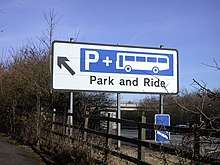Private transport
Private transport (as opposed to public transport) is the personal or individual use of transportation vehicles which are not available for use by the general public, where essentially the user can decide freely on the time and route of transit ('choice rider' vs. 'captive rider'[1]), using vehicles such as: private car, company car, bicycle, dicycle, self-balancing scooter, motorcycle, scooter, aircraft, boat, snowmobile, carriage, horse, etc., or recreational equipment such as roller skates, inline skates, sailboat, sailplane, etc. Private transport is in contrast to public transport, and commercial non-public transport (whose means of transport are, for example, excursion riverboats, tourist cable cars, resort ski lifts). While private transportation may be used alongside nearly all modes of public transportation, private railroad cars are rare (e.g. royal train). Unlike many forms of public transportation, which may be government subsidized or operated by privately owned commercial organizations for mass or general public use, the entire cost of private transportation is born directly or indirectly by the individual user. However some scholars argue that it is inaccurate to say that the costs are covered by individual user because big (and often dominant) part of cost of private transportation is the cost of infrastructure on which individual trips rely. They therefore work also with model of quasi-private mobility.[2]
_(14596082918).jpg)
Public transport depicted; ambulance, charabanc, horsecar, mailcoach, motorbus, rickshaw, stagecoach, steam locomotive, streetcar

Private transportation includes both non-motorized methods of private transit (pedestrians, cyclists, skaters, etc.) and all forms of self-propelled transport vehicles.
Non-scheduled transit vehicles, taxicabs and rickshaws, which are rented or hired in the short-term on-demand with driver, belong, even if the user can freely decide on the time and route of transit, to the special forms of 'public transport'.
Private transport is the dominant form of transportation in most of the world. In the United States, for example, 86.2% of passenger miles are by passenger vehicles, motorcycles, and trucks.[3]
Examples of private transport
.jpg)
- Motorized:
- Non-motorized:
Cycling and walking, above all, have been recognized as the most sustainable transport systems. In general, all muscle-driven mobility will have a similar energy efficiency while at the same time being almost emission-free (apart from the CO2 exhaled during breathing).
The negative environmental impact of private transport can be alleviated by choosing the optimal modal share for a given environment and transport requirements.
Dedicated infrastructure
- Automobile repair shop
- Controlled-access highway
- Diner
- Drive-thru
- Drive-in theater
- Filling station
- Garage (residential)
- Motel
- Parking lot
- Rest area
- Retail park
- Roadside zoo
- Safari park
See also
References
- "Transportation Research Thesaurus: Captive riders". The National Academies of Sciences, Engineering, and Medicine. The National Academies of Sciences, Engineering, and Medicine. Retrieved 2019-04-02.
- Urry, John (October 2004). "The 'System' of Automobility". Theory, Culture & Society. 21 (4–5): 25–39. doi:10.1177/0263276404046059. ISSN 0263-2764.
- "Table 4-3 Passenger-Miles: 1990-2005". bts.gov. Bureau of Transportation Statistics. Retrieved 12 Mar 2008.